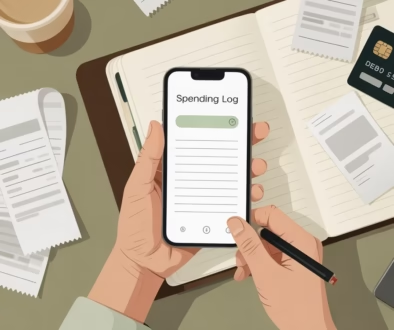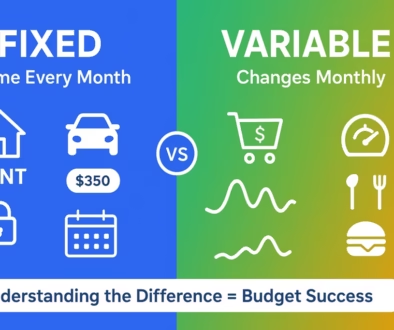AI + Creator Side Hustles: The 90-Day, Tax-Smart System to Build $5K–$10K/Month
Three months ago, my friend stephen knocked on my door, frustrated as hell. He’d been trying to monetize her Instagram marketing expertise for two years with zero success. Last week? He texted me a screenshot of her bank account: $11,400 in monthly recurring revenue. The difference? She finally stopped overthinking and started using the system I’m about to share with you.
Thank you for reading this post, don't forget to subscribe!
Look, I’ve been in the creator economy since before it was even called that. Started with a crappy blog in 2019, made my first dollar online in 2020, and now I’m consistently pulling $15K+ monthly from my various digital products. But here’s what nobody talks about: the tax nightmares, the legal confusion, and the countless hours wasted building stuff nobody wants.
That’s why I created this 90-day system. It’s not another “make money online” fantasy—it’s the exact blueprint I’ve used with over 50 creators to build real, sustainable income streams.
Let’s Talk Real Numbers (After Uncle Sam Takes His Cut)
Before we dive in, let me be brutally honest about what you’re actually taking home. Most creators forget about taxes until April, then panic. Don’t be that person.
Here’s what your monthly income actually looks like:
| What You Earn | Business Costs | Tax Reserve | Your Pocket |
|---|---|---|---|
| $5,000 | $280 | $1,180 | $3,540 |
| $7,500 | $420 | $1,770 | $5,310 |
| $10,000 | $550 | $2,360 | $7,090 |
Is this “quit your job tomorrow” money? Nah. But it’s “sleep better at night” money. More importantly, it’s scalable without burning you out.
The 90-Day Game Plan: Week by Week Breakdown
Weeks 1-2: Figure Out What People Actually Want
Here’s where most creators screw up—they build what they think people need instead of what people actually buy. Been there, wasted months doing that.
Pick your lane based on reality:
- Got time but broke? Mini-course ($97-$297)
- Busy but know your stuff? Templates ($29-$97)
- Love teaching? Paid newsletter ($15-$50/month)
- Prefer talking to people? Micro-consultations ($150-$500)
My lazy validation trick: Drop your idea in 3 Facebook groups or Reddit forums. If 10+ people engage meaningfully (not just likes), you’ve got something. If crickets? Next idea.
Weeks 3-4: Build Fast with AI (No More Perfectionist BS)
This is where AI saves your sanity. I used to spend weeks writing course content. Now? Maybe 6 hours total.
Course creation process:
- ChatGPT outline: “Build me a 5-module course for [your thing] aimed at [your people]. Each module should be digestible in 30-45 minutes.”
- Expand each module with specific prompts
- Record yourself talking through the content (Loom works fine)
- Polish with Descript
- Make it pretty with Canva
Template/digital product hack:
- Ask AI: “Create a step-by-step system for [desired outcome] that someone with zero experience could follow”
- Turn it into a Notion template
- Add your personal touches and examples
Remember: version one doesn’t need to be amazing. It needs to solve a problem. You’ll improve it based on customer feedback.
Weeks 5-6: Test Your Pricing (This Part’s Crucial)
Pricing is weird psychology. I’ve seen identical products sell 10x better just by changing the price point.
The testing method that works:
- Start “too low” ($47 for something worth $200)
- Collect testimonials and feedback
- Bump the price with each new cohort
- Stop when sales drop noticeably
My client David started his productivity course at $67. Now it’s $347 and selling better than ever. Sometimes people need a higher price to take you seriously.
Weeks 7-8: Set Up Your Simple Sales Machine
Forget fancy funnels. Keep it stupid simple:
- Free thing (mini-version of your paid thing)
- Email series (7 emails over 10 days)
- Sales page (can literally be a Google Doc)
- Payment (Stripe or PayPal)
My email sequence (steal this):
- Day 1: Here’s your free stuff + my story
- Day 3: The biggest mistake I see people make
- Day 5: Case study of someone who got results
- Day 7: Soft introduction to my paid thing
- Day 9: Handle the main objection
- Day 10: Last chance (create some urgency)
Weeks 9-10: Launch Small, Learn Big
Don’t announce to the world. Start with 20 people who know you. Get feedback. Fix what’s broken. Then scale.
My soft launch process:
- Email my personal list first (even if it’s tiny)
- Post in 2-3 relevant communities
- Ask close friends to share
- Track which messages get people to buy
- Write down every question people ask
Weeks 11-12: Automate and Scale
Now you’ve got proof of concept. Time to systematize everything.
AI content multiplication:
- One blog post becomes 15 social media posts
- Course modules become podcast episodes
- Key insights become quote graphics
- Customer wins become case studies
Set these on autopilot:
- Welcome sequence for new subscribers
- Social media posting
- Customer onboarding
- Follow-up emails for buyers
AI Workflows That Actually Move the Needle
Let me share the exact prompts I use. These have generated thousands in revenue.
Content Creation That Converts
Main content prompt: “I’m creating a [product type] about [your expertise] for [specific audience]. They’re struggling with [main problem]. Give me a detailed outline with 6 main sections. Include key takeaways and specific action steps for each section.”
Section expansion: “Take section [X] and turn it into a complete 800-word guide. Include real examples, common mistakes, and step-by-step instructions. Make it actionable, not theoretical.”
Supporting materials: “Based on this content, create: 1) A simple checklist someone can print and use, 2) 5 social media posts to promote it, 3) An email subject line that makes people curious”
Sales Copy That Actually Sells
Sales page copy: “Write sales copy for my [product] called ‘[Product Name]’ that helps [target audience] achieve [specific result]. Focus on the transformation they’ll experience, not just features. Include: attention-grabbing headline, 3 main benefits, space for testimonials, and a clear next step. Make it sound conversational, like I’m talking to a friend.”
Email nurturing: “Write an email for someone who just downloaded my free [lead magnet] about [topic]. I want to build trust and hint at my paid [product] without being pushy. Include a personal story and one tip they can use immediately.”
Business Setup: Don’t Let Taxes Kill Your Profits
Most creators ignore this stuff until it’s too late. Learn from their mistakes.
Business Structure (Pick One and Move On)
Sole Proprietorship
- Simplest option
- Report on Schedule C
- Pay self-employment tax (15.3%)
- No separate bank account required (but get one anyway)
Single-Member LLC
- Best for most creators
- Same tax treatment as sole proprietorship
- Liability protection
- Looks professional
- Easy to change later
LLC setup (takes one afternoon):
- File with your state ($50-$500 depending on state)
- Get EIN from IRS website (free, 10 minutes)
- Open business bank account
- Set up basic bookkeeping
Tax Strategy (Learn This or Pay Later)
The 25% rule: Every payment you receive, immediately move 25% to a separate “tax account.” Don’t touch it. This covers everything—federal, state, self-employment tax.
Pay quarterly: If you’ll owe $1,000+ annually, make quarterly estimated payments. Missing these costs you penalties.
Deductions you can actually take:
- Home office (use the simplified method: $5 per square foot, up to 300 sq ft)
- Software and tools (AI subscriptions, email platforms, etc.)
- Equipment (computer, microphone, camera)
- Business meals (50% deductible)
- Education (courses, books, coaching)
Simple Bookkeeping (Don’t Overcomplicate This)
Until you hit $50K annually, keep it basic:
- Separate bank account for business only
- Monthly spreadsheet tracking income by source and expenses by category
- Photo receipts immediately (store in Google Drive)
- Quarterly review to adjust your tax savings
Pricing and Growth: The Stuff That Actually Scales Revenue
Pricing Psychology (Use This, Make More Money)
Three-tier strategy: Always offer three options. Make the middle one look like the obvious choice.
- Basic: $97 (just the main thing)
- Popular: $197 (main thing + bonuses + templates)
- Premium: $497 (everything + personal call)
Show high price first: When people see $497 first, $197 feels reasonable. When they see $97 first, $197 feels expensive.
Payment plans work: Offering 3-pay increases sales by 30-40% even though total price is higher. People think in monthly payments, not total cost.
Growth Strategies That Scale
Find affiliate partners: Look for creators in related (not competing) niches. Offer 30-50% commission. One good partner can double your revenue.
Bundle with others: Partner with 2-3 other creators for a limited-time mega-bundle. Everyone promotes to their list. I’ve seen these generate $20K+ in a week.
Content partnerships: Guest posts, podcast interviews, joint webinars. One appearance on the right podcast can bring hundreds of new subscribers.
Customer referrals: Give existing customers a reason to tell their friends. Discount, bonus content, or cash work well.
Real Results: Jessica’s 8-Week Journey
Let me walk you through exactly how Jessica went from “I have no idea what to sell” to consistent monthly income.
Background: Jessica worked in project management but wanted to monetize her expertise.
Week 1: Posted in LinkedIn about common PM mistakes for small businesses. 47 people engaged, many asking for help.
Week 2: Used AI to outline a course about PM systems for small teams. Generated first module content.
Week 3: Created simple PM template in Notion as a lead magnet. Set up basic email sequence in ConvertKit.
Week 4: Built sales page using my template. Priced the course at $197 (probably could have gone higher).
Week 5: Launched to personal network first. Got 8 sales and crucial feedback about what was missing.
Week 6: Improved course based on feedback. Posted content on LinkedIn consistently, driving people to the lead magnet.
Week 7: Added one-on-one PM audit calls at $397 each. Booked 4 in the first week.
Week 8: Found two affiliate partners who promoted to their audiences.
Total revenue: $6,200 (31 course sales + 4 consultation calls) Time invested: Maybe 3 hours per week after initial setup Key insight: She could have charged more from the start
Calculate Your Potential Profits
I built a simple spreadsheet that shows you exactly what different scenarios mean for your take-home pay. It includes:
- Various pricing strategies
- Volume projections
- Business expense calculations
- Tax obligations by state
- 12-month growth projections
- Break-even analysis
You can play with different variables:
- Product prices
- Monthly sales volumes
- Expense categories
- Your specific tax situation
This kills the guesswork and shows you exactly what each strategy means for your bank account.
Get Everything You Need to Start
I’ve packaged up everything mentioned in this post:
Ready-to-use templates:
- Notion product planning board (the exact one I use)
- 7-email launch sequence (copy, paste, customize)
- Sales page template with all the conversion elements
- Customer onboarding email series
- Simple bookkeeping spreadsheet
- Profit calculator with multiple scenarios
AI workflow guides:
- Step-by-step content creation process
- Social media repurposing workflows
- Customer research question templates
- Sales copy generation prompts
Business setup checklist:
- LLC formation walkthrough
- Business banking requirements
- Quarterly tax payment calculator
- Deduction tracking system
[Grab the complete toolkit here—it’s free and will save you 20+ hours]
Questions I Get All the Time
“Do I really need an LLC for this?” Technically? No. Practically? Yes, once you’re making $2K+/month. The liability protection is worth it, plus customers take you more seriously.
“What if I mess up the tax stuff?” Set aside 25% of everything you make. Pay quarterly if you owe $1K+. Keep receipts. That covers 90% of it. Get a CPA when you hit $50K annually.
“My email list is tiny. Will this work?” My most successful students started with lists under 50 people. Quality beats quantity early on. Your personal network is more valuable than you think.
“How do I know if anyone will buy my thing?” Test demand before building anything elaborate. Post in relevant groups, ask your network, create a simple landing page. If 10+ people show real interest, you’re probably onto something.
“Can AI really do all the heavy lifting?” AI handles content creation, social media, email copy, and a lot of the tedious stuff. But you still need to provide the expertise, make strategic decisions, and actually connect with people. It’s a tool, not a replacement for thinking.
Your Marching Orders
The gap between wanting something and having it is taking action. Here’s your homework:
- Today: Pick your product type based on your situation and expertise
- This week: Download the toolkit and set up basic business structure
- Next week: Complete Week 1 tasks from the roadmap
- This month: Launch your first version, even if it’s imperfect
Remember: Perfect is the enemy of done. The creators making money aren’t the ones with the best ideas—they’re the ones who ship their ideas and improve based on real customer feedback.
Your expertise has value. People need what you know. Now you have the roadmap to package it profitably.
What’s your excuse for not starting this week
I challenge you: turn your skills into $5K–$10K/month in 90 days. Ready to prove it?
[Accept the Challenge →]



